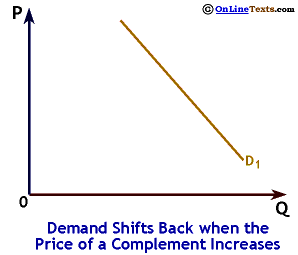
Complementary goods are goods consumed together, so when the price of one of them increases, the price of consuming the combined good increases. For this reason, an increase in the price of a complement shifts the demand curve for the other good back.
Consider a consumer who enjoys peanut butter and jelly sandwiches. To the right is her yearly demand for peanut butter. The prices on the vertical axis are prices of jars of peanut butter, and on the horizontal axis are the quantities she buys in a year. The price of jelly is not shown on this graph. When jelly sells for $1.00 per jar, her demand for peanut butter is given by demand curve D1, but if the price of jelly increases to $3.00 per jar, her demand curve for peanut butter shifts back (decreases) to D2.
The reason for this should be clear. When the price of jelly is low, the cost of making peanut butter and jelly sandwiches is low, but when the price of jelly is high, it costs more to make PB&J sandwiches. Thus, her demand for peanut butter shifts back (decreases) and she buys less peanut butter at every price when the price of jelly rises.

